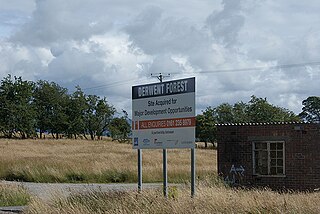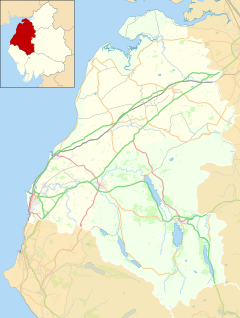
Allerdale was a non-metropolitan district of Cumbria, England, with borough status. Its council – Allerdale Borough Council – was based in Workington, and the borough had a population of 96,422 at the 2011 census.

Tallentire is a village and former civil parish, now in the parish of Bridekirk, in the Cumberland district of Cumbria, England. It is about 2.5 miles (4.0 km) north of Cockermouth. The village is located just outside the Lake District National Park. In 1931 the parish had a population of 184.

Brigham is a village in Cumbria, England. The village is near to the town of Cockermouth and is located just outside the Lake District National Park.

Above Derwent is a civil parish in Cumbria, England, to the west of Derwentwater and Keswick. It lies entirely within the Lake District National Park.

Broughton is a civil parish in Cumbria, England, consisting of Great Broughton and Little Broughton. It is located on the River Derwent, about 6 miles (9.7 km) east of Workington and 3 miles (4.8 km) west of Cockermouth. According to the 2001 census it had a population of 1,727, decreasing slightly to 1,704 at the 2011 Census.

Broughton Moor is a village and civil parish in Cumbria, England. It is situated on an extensive moor about 2 miles (3.2 km) north of Broughton, 5 miles (8.0 km) north west of Cockermouth, 2.5 miles (4.0 km) south of Maryport and 4.5 miles (7.2 km) north of Workington.

Greysouthen is a village and civil parish between the towns of Workington and Cockermouth, in Cumbria, North West England, historically part of Cumberland, near the Lake District National Park. The village has an historic association with coal mining.

Bridekirk is a village and civil parish in the Cumberland district in the county of Cumbria, England. It is around 3.2 kilometres (2 mi) north of the Derwent river and about the same distance from the nearest large town of Cockermouth just south of the river. Bridekirk is just outside the Lake District National Park and is not far from the Maryport and Carlisle Railway.

Camerton railway station was situated next to the River Derwent on the Cockermouth and Workington Railway. It served the village of Camerton, Cumberland, England.

Camerton is a small village and civil parish in Cumbria, historically part of Cumberland, near the Lake District National Park in England. According to older maps, it was originally called "Camberton".

Ullock is a village in Cumbria, England, located at National Grid reference NY076239, approximately 5 miles (8.0 km) south west of Cockermouth and 5.4 miles (8.7 km) south east of Workington. The River Marron flows through the village. It is located just outside the Lake District National Park. In 1870-72 the township had a population of 353.

RNAD Broughton Moor is a decommissioned Royal Naval Armaments Depot located between Great Broughton and Broughton Moor in the County of Cumbria, England.

Little Broughton is a village and former civil parish, now in the parish of Broughton, in the Allerdale district, in the county of Cumbria, England, located 3 miles (4.8 km) west of Cockermouth. In 1891 the parish had a population of 820.

Great Broughton railway station briefly served the village of Great Broughton, near Cockermouth in Cumberland, England.

Eaglesfield is a village in the parish of Dean in Cumberland in Cumbria, England. It is near the A5086 road, 2.5 miles (4 km) southwest of Cockermouth and is located just outside the Lake District National Park. In 1931 the parish had a population of 233.

Dovenby is a village and former civil parish, now in the parish of Bridekirk, in the Cumberland district, in the county of Cumbria, England. It is on the A594 road and is 2.5 miles (4.0 km) north west of Cockermouth, 2.6 miles (4.2 km) east of Dearham, 4.5 miles (7.2 km) east of Maryport, 7.4 miles (11.9 km) north east of Workington and 27 miles (43.5 km) south west of Carlisle. In 1931 the parish had a population of 163.

Great Clifton is a village and civil parish in the Cumberland district in the English county of Cumbria. In the 2001 census, it has a population of 1,101, increasing slightly to 1,114 at the 2011 Census.

Linefoot railway station, sometimes referred to as Linefoot Junction and sometimes as Linefoot Goods, briefly served the scattered community around the crossroads at Linefoot, near Cockermouth in Cumberland, England.

Stainburn is a settlement and former civil parish about 7 miles from Whitehaven, now in the parish of Workington, in the county of Cumbria, England. In 2018 the built-up area had an estimated population of 1705. Stainburn was also a ward, in 2011 the ward had a population of 1694. In 1961 the parish had a population of 246. Stainburn was on the A66 road until 20 December 2002 when it was bypassed.

Penrith and Solway is a constituency of the House of Commons in the UK Parliament Further to the completion of the 2023 Periodic Review of Westminster constituencies, it was contested for the first time at the 2024 general election, since when it has been represented by Markus Campbell-Savours of the Labour Party.





















